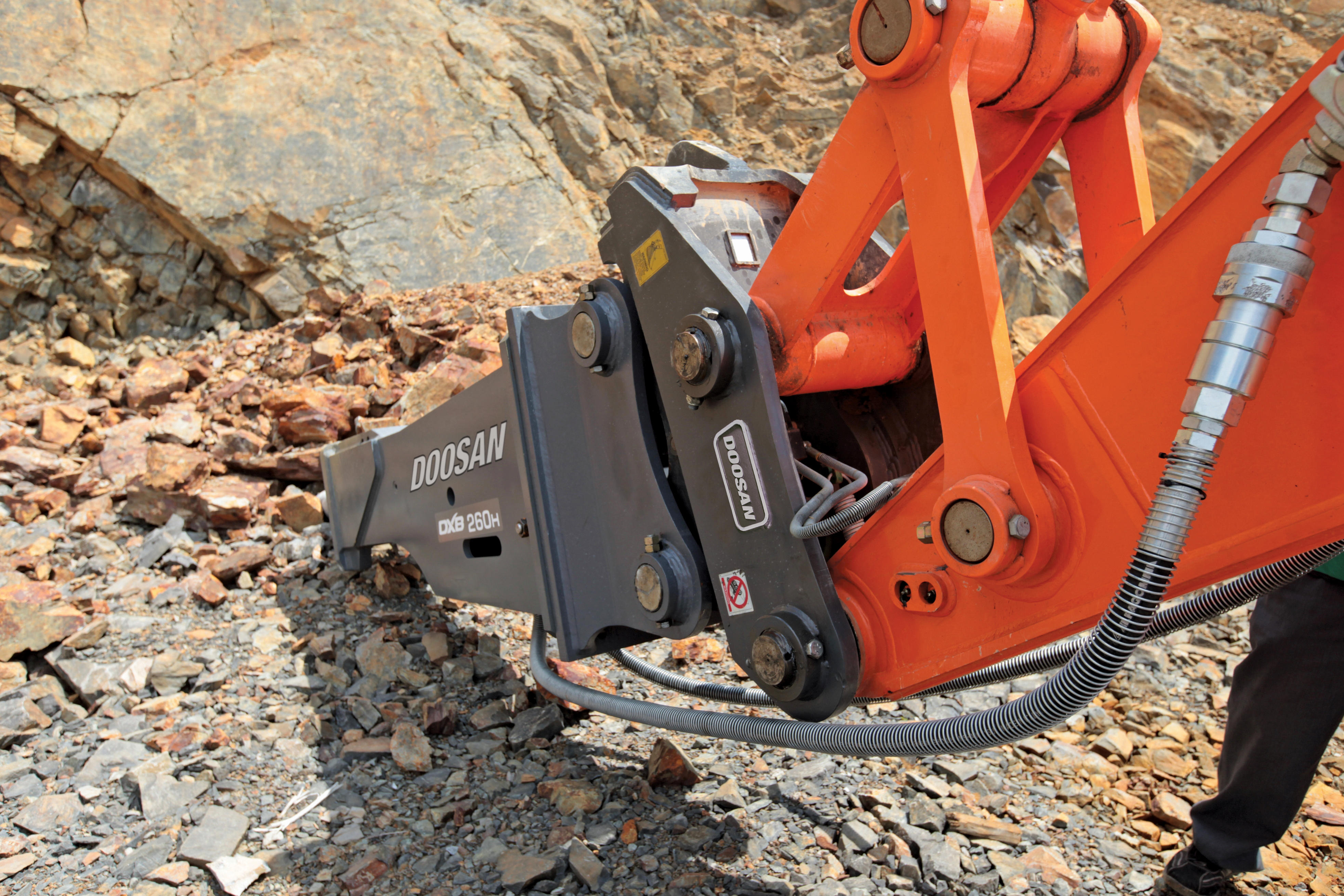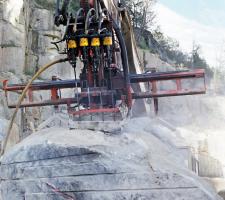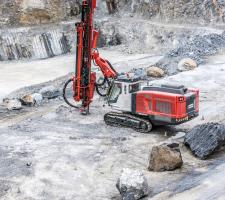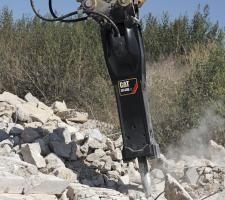
The Parque Natural das Serras de Aire e Candeeiros national park in Portugal is a major tourist attraction. Patrick Smith reports
With its rugged limestone hills and upland farmland, divided by ancient stone walls, it is also the centre of operations for a number of large limestone quarries.
Previously, many quarries used
“These offer the same high performance but with a 5dB(A) lower noise level,” says Atlas Copco.
“In the early days some of the limestone quarries in the area worked with Atlas Copco hand-held rock drills. In time, as production demands increased and more mechanisation was needed, the introduction of the drilling column led to widespread use of Atlas Copco BBD 94 DSI pneumatic rock drill.”
Some of the quarries in the national park are situated close to urban areas and quarry owners were concerned that complaints from residents about drilling noise levels could threaten their exploration permits.
Environmental pressure in the area is strong: out of an initial 120 exploration permits issued, there are now only about 40 quarries in operation.
Environmental concerns are often behind a quarry operator’s decision to look for alternative methods of primary and secondary rock breaking or drilling and blasting.
Indeed, in quarrying operations the processes are often subjected to profitability analysis.
“Overall, hydraulic breakers are often the most economical and safest option,” says Atlas Copco, which offers a selection of surface drills for drill and blast operations.
A standard application is secondary reduction of oversize boulders in the rock pile, and the use of hydraulic breakers here has made safety problems a thing of the past.
Hydraulic breakers are particularly suitable for quarries where: loading is primarily done by wheeled loaders; backhoe loaders are used; heavy-duty excavators with service weights upward of 150tonnes are in use; conditions make a high percentage of oversize boulders inevitable; the rock to be loaded is very tough; or where secondary reduction work is sub-contracted.
However,
“The popularity is due in part because of advanced hydraulic systems, which have allowed ripping to actually become a production process,” says Caterpillar.
“Track-type tractors with rear-mounted rippers are the traditional tool. However, large Cat hydraulic excavators feature enough hydraulic strength to pull rippers through rock that would have been thought impossible to penetrate only a few years ago. Some rippers are available in both pin-in and quick coupler settings. The rippers are built for heavy work, with reinforced, one-piece shanks. Add an increased hydraulic flow and you get production power.”
Cat, which offers a variety of rippers from 160kg up to over 2tonnes, says its units are ready for even tougher materials, and can easily handle the reduction of quarry oversize.
“A combination of advanced hydraulic systems, more machine weight and greater horsepower have greatly improved the ripping performance and efficiency of hydraulic excavators, track-type tractors and other machines,” says Caterpillar.
“So if you’re looking for a way to avoid blasting, you might want to give ripping another look.”
Meanwhile, at the Portuguese quarry, Atlas Copco initiated a partnership with local distributor DRCP-Ferramentas e Equipamentos, who conducted field tests using the BBC 34 DSI as an alternative to the BBD 94 DSI machines.
“The field tests showed that the BBC 34 DSI provides the same high penetration rate as the BBD 94 DSI, but with a noise reduction of 5dB(A), and this is experienced by the human ear as a 50% lower noise level,” says Torres Marques, business line manager, Atlas Copco Portugal.
The BBC 34 DSI pneumatic rock drill has a piston diameter of 80mm, a long stroke of 70mm, and a powerful rifle bar rotation mechanism.
It delivers high impact energy per blow and is said to be highly efficient in medium to hard rock.
The large piston diameter enables it to maintain high efficiency even at low air pressure, and maintenance intervals are longer than for the BBD 94 DSI.
“We are now recommending the BBC 34 DSI to the limestone quarries and have approximately 20 units operating in this area,” says Marques.
“Our customers no longer have concerns regarding noise levels disturbing the local residents.”
Meanwhile,
Intended for demolition, construction, quarrying and mining applications, the new series has been launched for the European market with the introduction of the DXB100H, DXB130H, DXB170H, DXB190H and DXB260H models, which cover carrier weights from 10-34tonnes.
“DXB technology ensures the carrier is protected from the effects of reduction in pressure peaks,” says Doosan.
“The breakers include an energy recovery system and a patented valve system, increasing overall performance; a high quality piston and cylinder manufactured to precise tolerances, and an advanced dampening system to protect the breakers against blank firing. The close tolerances of the parts used in the breakers result in lower maintenance costs.”
The Doosan DXB190H is suitable for 22-30tonne excavators while the DXB260H breaker is designed for use on 27-34tonne excavators.
“The superior power-to-weight ratios of these breakers provide very efficient reduction of rock, boulders, concrete and other demolition waste, as well as excellent excavation work.”
Doosan’s DXB100H is suitable for carriers in the 10–20tonne range; DXB130H (15-22tonne) and DXB170H (18–28tonne).
Now available in Europe, the Middle East, Africa (EMEA) and across the Asia Pacific (APAC) region, are Volvo Construction Equipment’s new series of HB hydraulic breakers for 14-70tonne excavators.
“With operating weights of 909kg to 6,031kg, the 11 breakers in Volvo’s HB14 to HB70 series work together in perfect harmony with Volvo’s excavators, from the EC140 up to the EC700, delivering consistent power and breaking force,” says
“These breakers are also exactly tailored to the machine’s hydraulic technology, further enhancing performance.”
The breakers are self-greasing and encased in a fully sealed housing to protect the power cell, prolong their lifespan and reduce noise. Their hydraulic systems are protected from pressure spikes by large capacity accumulators, which also serve to increase impact power.
“For flexibility and increased productivity, the operator can adapt frequency to the application using the breaker’s dual-speed control. A cushion damper reduces noise and vibration back through the machine, for greater operator comfort and safety, as well as decreased risk of damage to the boom and arm,” says Volvo CE.
Anti-blank firing prevents the breaker from continuing to strike once material has been completely penetrated.
Volvo CE points out that the HB-Series can also be adapted, depending on the application, with a variety of tools including moils, pyramid moils, chisels and blunts.
“HB-Series breakers can be purchased in a comprehensive all-in-one package, which includes hydraulic hoses, breaker bracket (this comes as standard in some markets) and breaker tools, so they can go to work right away, no matter whether they’re being attached to new machines or integrated into an existing fleet.”
In Italy two
A harbour, almost totally abandoned since the early 1970s and standing between two massive sea walls, has remained virtually unused. This is mainly because rocky shoals, formed by limestone (they make up much of the nearby coastline) inside the harbour, required excavation.
Sandy materials at the site have been removed using a trailing suction dredger but for the rock excavation, excavation contractor Trani Scavi from Trani, near Bari, used two Indeco hydraulic breakers, an HP 5000 mounted on a Cat 325D excavator and an HP 7000 mounted on a Cat 330D, to remove some 40,000m³ in about four months.
Trani Scavi has been using Indeco breakers for over 25 years, and also has Indeco HP 3000, HP 500 and HP 1800 breakers.
In the USA, where the last few years have been a difficult time for the construction industry, with drilling being hit as hard as any other sector of the industry, Okie Drilling says it continues to grow with help from
The company was established in 2003 by Billy and Gary White, and the core of the business is drilling for rock quarries and state road projects.
The company has been extensively using the Sandvik RH550 series hammers, part of Sandvik's extensive range of tools for down-the-hole (DTH) drilling, with the range including hammers, drill bits and tool systems for simultaneous drilling and casing through difficult overburden.
Bits are available in a wide range of configurations and in sizes ranging from 90mm-445mm.
Billy White says the Sandvik RH550 hammers have improved Okie’s bottom line.
“I’m now paying $3.20 per gallon for diesel fuel and many of the drills use 25 gallons per hour, or almost $800 per day for fuel. The extra performance from the Sandvik hammers means we can save up to $320 per day just in fuel,” says Billy White.
Indeed, the Swedish-headquartered company is finding success over the border with Castonguay Blasting, a Quebec, Canada-based drilling and blasting contractor, whose recent surface drilling fleet additions include four Sandvik DP1500i units.
Castonguay Blasting handles challenging drill and blast projects in quarrying, open pit mining, construction work and in other applications, using its 40 years of industry experience to work closely with quarry operators. These include Graymont’s Marbleton limestone quarry, Quebec, which supplies the company’s lime plant nearby.
Quarry production is some 2 million tonnes of rock (primarily a relatively soft limestone) a year, and the operation is now placing increasing reliance on Castonguay’s Sandvik DP1500i rigs, and their operators, to help produce the material.
The quarry achieves its high production level while operating on a single shift basis five days a week, and still manages 25-27m of drilling/hour.
While many quarries rely on down-the-hole (DTH) rigs, at Marbleton quarry it is claimed that Castonquay’s Sandvik DP1500i tophammer units “have been found to outperform comparable DTH rigs in the fleet in terms of drilling performance, precision and in particular, fuel economy.”
Tapani Sormunen, Sandvik’s engineering manager, New Products, Surface Drills, says: “We set three key environmental targets: one was lower fuel consumption, and the other two minimising noise and dust emissions.
“We developed a new way of measuring fuel consumption which also incorporates the productivity aspect. While the previous measurement unit for fuel consumption was litres per hour, we now count litres per drilled metre.”
The DP1500i drills good sized holes using Sandvik GT60 rock tools (used on other Castonguay rigs) and has seen a deviation of just 1o in a 26m hole.
Meanwhile, UK company Dando Drilling International’s ultra-small, compact Dando Terrier, designed as a multi-purpose drilling rig capable of using techniques from drive sampling to down the hole hammer drilling (DTH), has new features.
Capable of deploying a standard penetration test (SPT), dynamic probing and undisturbed sampling techniques for geotechnical investigation and environmental analysis, the crawler-mounted machine now offers front-mounted drilling controls, allowing a good view of the drill string and safe operation of the rig when connecting up additional tooling.
The blow counter is installed next to the control panel and the addition of a new sampling hammer feature allows the rig to perform rapid undisturbed sampling up to 66mm in diameter in conjunction with rotary drilling techniques.
A quick connect circuit is fitted as standard to the Terrier hydraulic system, and it runs the sampling hammer as well as other equipment, including sand guzzlers and casing jacks. A 1m measurement scale for the easy monitoring of progress is attached to the mast.


















